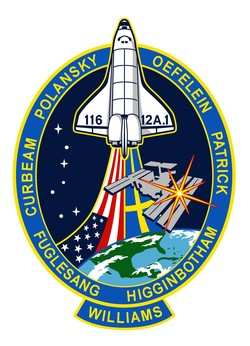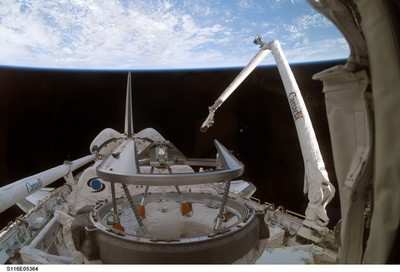Thu, Dec 21, 2006
Landing Scheduled For Friday
 The STS-116 crew onboard
the shuttle Discovery conducted a final inspection of the orbiter's
heat shield Wednesday, in preparation for landing.
The STS-116 crew onboard
the shuttle Discovery conducted a final inspection of the orbiter's
heat shield Wednesday, in preparation for landing.
STS-116 Commander Mark Polansky, Pilot Bill Oefelein and Mission
Specialist Nicholas Patrick used the shuttle’s robotic arm
and boom extension sensor system to check the heat shield for any
space junk or micrometeoroid hits that may have occurred while the
orbiter was docked to the International Space Station.
Mission Specialists Bob Curbeam, Christer Fuglesang, Joan
Higginbotham and Thomas Reiter are stowing items in preparation for
the return to Earth. Discovery is slated to touch down at 3:56 pm
EST Friday at Florida's Kennedy Space Center... but weather could
force a delay, or a landing at an alterate site in New Mexico or
California.
Two small scientific satellites were deployed from the payload
bay Wednesday night. The Microelectromechanical System-Based
PICOSAT Inspector (MEPSI) mini-satellite was released at 7:16 pm.
MEPSI will demonstrate the use of tiny, low-power satellites to
observe larger spacecraft by testing the function of small camera
systems and gyroscopes.
The Radar Fence Transponder (RAFT) satellite was released 90
minutes later, at 8:56 pm. RAFT is a student experiment from the
United States Naval Academy that uses picosatellites to test the
Space Surveillance Radar Fence.
As Aero-News reported,
Discovery undocked from the station Tuesday, ending an eight-day
stay at the orbital outpost. While there, the crew continued the
on-orbit construction of the station with the addition of the P5
spacer truss segment during the first of four spacewalks. The next
two spacewalks were devoted to the rewiring of the station’s
power system, leaving it in a permanent setup. A fourth spacewalk
was added to allow the crew to retract solar arrays that had folded
improperly.
Discovery also delivered a new crew member and more than two
tons of equipment and supplies to the station. Almost two tons of
items no longer needed on the station will return to Earth with
STS-116.

European Space Agency astronaut Reiter is also returning with
the Discovery crew, after his six month stay onboard the ISS as a
member of both Expedition 13 and Expedition 14 crews.
More News
Light Gun A handheld directional light signaling device which emits a brilliant narrow beam of white, green, or red light as selected by the tower controller. The color and type of>[...]
"The journey to this achievement started nearly a decade ago when a freshly commissioned Gentry, driven by a fascination with new technologies and a desire to contribute significan>[...]
Aero Linx: JAARS, Inc. For decades now, we’ve landed planes on narrow rivers and towering mountains. We’ve outfitted boats and vehicles to reach villages that rarely se>[...]
"Our driven and innovative team of military and civilian Airmen delivers combat power daily, ensuring our nation is ready today and tomorrow." Source: General Duke Richardson, AFMC>[...]
Aircraft Conflict Predicted conflict, within EDST of two aircraft, or between aircraft and airspace. A Red alert is used for conflicts when the predicted minimum separation is 5 na>[...]
 ANN's Daily Aero-Term (04.20.24): Light Gun
ANN's Daily Aero-Term (04.20.24): Light Gun Aero-News: Quote of the Day (04.20.24)
Aero-News: Quote of the Day (04.20.24) ANN's Daily Aero-Linx (04.21.24)
ANN's Daily Aero-Linx (04.21.24) Aero-News: Quote of the Day (04.21.24)
Aero-News: Quote of the Day (04.21.24) ANN's Daily Aero-Term (04.21.24): Aircraft Conflict
ANN's Daily Aero-Term (04.21.24): Aircraft Conflict




